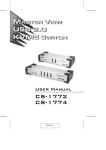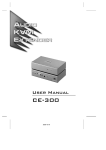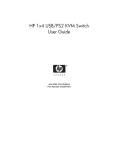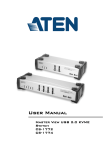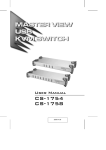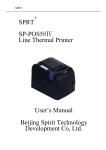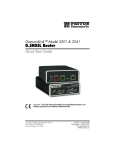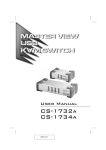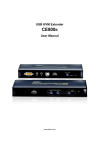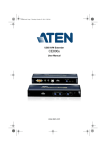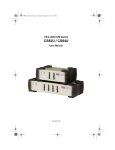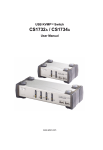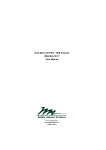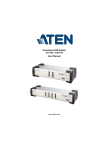Download CS-1742 CS-1744
Transcript
User Manual CS-1742 CS-1744 CS-1742 / CS-1744 User Manual FCC Information This is an FCC Class A product. In a domestic environment this product may cause radio interference in which case the user may be required to take adequate measures. This equipment has been tested and found to comply with the limits for a Class A digital device, pursuant to Part 15 of the FCC Rules. These limits are designed to provide reasonable protection against harmful interference when the equipment is operated in a commercial environment. This equipment generates, uses and can radiate radio frequency energy and, if not installed and used in accordance with the instruction manual, may cause harmful interference to radio communications. Operation of this equipment in a residential area is likely to cause harmful interference in which case the user will be required to correct the interference at his own expense. RoHS This product is RoHS compliant. ii CS-1742 / CS-1744 User Manual User Notice All information, documentation, and specifications contained in this manual are subject to change without prior notification by the manufacturer. The manufacturer makes no representations or warranties, either expressed or implied, with respect to the contents hereof and specifically disclaims any warranties as to merchantability or fitness for any particular purpose. Any of the manufacturer's software described in this manual is sold or licensed `as is'. Should the programs prove defective following their purchase, the buyer (and not the manufacturer, its distributor, or its dealer), assumes the entire cost of all necessary servicing, repair and any incidental or consequential damages resulting from any defect in the software. The manufacturer of this system is not responsible for any radio and/or TV interference caused by unauthorized modifications to this device. It is the responsibility of the user to correct such interference. The manufacturer is not responsible for any damage incurred in the operation of this system if the correct operational voltage setting was not selected prior to operation. PLEASE VERIFY THAT THE VOLTAGE SETTING IS CORRECT BEFORE USE. iii CS-1742 / CS-1744 User Manual Safety Instructions General Read all of these instructions. Save them for future reference. Follow all warnings and instructions marked on the device. Do not place the device on any unstable surface (cart, stand, table, etc.). If the device falls, serious damage will result. Do not use the device near water. Do not place the device near, or over, radiators or heat registers. The device cabinet is provided with slots and openings to allow for adequate ventilation. To ensure reliable operation, and to protect against overheating, these openings must never be blocked or covered. The device should never be placed on a soft surface (bed, sofa, rug, etc.) as this will block its ventilation openings. Likewise, the device should not be placed in a built in enclosure unless adequate ventilation has been provided. Never spill liquid of any kind on the device. Unplug the device from the wall outlet before cleaning. Do not use liquid or aerosol cleaners. Use a damp cloth for cleaning. The device should be operated from the type of power source indicated on the marking label. If you are not sure of the type of power available, consult your dealer or local power company. The device is equipped with a 3-wire grounding type plug. This is a safety feature. If you are unable to insert the plug into the outlet, contact your electrician to replace your obsolete outlet. Do not attempt to defeat the purpose of the grounding-type plug. Always follow your local/national wiring codes. Do not allow anything to rest on the power cord or cables. Route the power cord and cables so that they cannot be stepped on or tripped over. If an extension cord is used with this device make sure that the total of the ampere ratings of all products used on this cord does not exceed the extension cord ampere rating. Make sure that the total of all products plugged into the wall outlet does not exceed 15 amperes. To help protect your system from sudden, transient increases and decreases in electrical power, use a surge suppressor, line conditioner, or un-interruptible power supply (UPS). Position system cables and power cables carefully; Be sure that nothing rests on any cables. iv CS-1742 / CS-1744 User Manual When connecting or disconnecting power to hot-pluggable power supplies, observe the following guidelines: Install the power supply before connecting the power cable to the power supply. Unplug the power cable before removing the power supply. If the system has multiple sources of power, disconnect power from the system by unplugging all power cables from the power supplies. Never push objects of any kind into or through cabinet slots. They may touch dangerous voltage points or short out parts resulting in a risk of fire or electrical shock. Do not attempt to service the device yourself. Refer all servicing to qualified service personnel. If the following conditions occur, unplug the device from the wall outlet and bring it to qualified service personnel for repair. The power cord or plug has become damaged or frayed. Liquid has been spilled into the device. The device has been exposed to rain or water. The device has been dropped, or the cabinet has been damaged. The device exhibits a distinct change in performance, indicating a need for service. The device does not operate normally when the operating instructions are followed. Only adjust those controls that are covered in the operating instructions. Improper adjustment of other controls may result in damage that will require extensive work by a qualified technician to repair. v CS-1742 / CS-1744 User Manual Rack Mounting Before working on the rack, make sure that the stabilizers are secured to the rack, extended to the floor, and that the full weight of the rack rests on the floor. Install front and side stabilizers on a single rack or front stabilizers for joined multiple racks before working on the rack. Always load the rack from the bottom up, and load the heaviest item in the rack first. Make sure that the rack is level and stable before extending a device from the rack. Use caution when pressing the device rail release latches and sliding a device into or out of a rack; the slide rails can pinch your fingers. After a device is inserted into the rack, carefully extend the rail into a locking position, and then slide the device into the rack. Do not overload the AC supply branch circuit that provides power to the rack. The total rack load should not exceed 80 percent of the branch circuit rating. Ensure that proper airflow is provided to devices in the rack. Do not step on or stand on any device when servicing other devices in a rack. vi CS-1742 / CS-1744 User Manual Package Contents The complete CS-1742 / CS-1744 package consists of: 1 CS-1742 or CS-1744 USB KVM Switch 2 Custom Audio/Video Cable Sets (CS-1742) 2 Custom USB/Video Cable Sets (CS-1742) 4 Custom Audio/Video Cable Sets (CS-1744) 4 Custom USB/Video Cable Sets (CS-1744) 1 Firmware Upgrade Cable 1 User Manual* 1 Quick Start Guide Check to make sure that all the components are present and that nothing got damaged in shipping. If you encounter a problem, contact your dealer. Read this manual thoroughly and follow the installation and operation procedures carefully to prevent any damage to the unit, and/or any of the devices connected to it. * Features may have been added to this product since the manual was written. Visit our website to download the latest version of this manual. © Copyright 2006 ATEN® International Co., Ltd. Manual Part No. PAPE-XXXX-XXXX Printing Date: 05/2006 ATEN and the ATEN logo are registered trademarks of ATEN International Co., Ltd. All rights reserved. All other brand names and trademarks are the registered property of their respective owners. vii CS-1742 / CS-1744 User Manual This Page Intentionally Left Blank viii CS-1742 / CS-1744 User Manual Contents FCC Information . . . . . . . . . . . . . . . . . . . . . . . . . . . . . . . . . . . . . . . . . . . . . ii User Notice . . . . . . . . . . . . . . . . . . . . . . . . . . . . . . . . . . . . . . . . . . . . . . . . .iii Safety Instructions. . . . . . . . . . . . . . . . . . . . . . . . . . . . . . . . . . . . . . . . . . . iv General . . . . . . . . . . . . . . . . . . . . . . . . . . . . . . . . . . . . . . . . . . . . . . . . iv Rack Mounting . . . . . . . . . . . . . . . . . . . . . . . . . . . . . . . . . . . . . . . . . . vi Package Contents. . . . . . . . . . . . . . . . . . . . . . . . . . . . . . . . . . . . . . . . . . . vii About this Manual . . . . . . . . . . . . . . . . . . . . . . . . . . . . . . . . . . . . . . . . . . . xi Conventions . . . . . . . . . . . . . . . . . . . . . . . . . . . . . . . . . . . . . . . . . . . . . . . xii Getting Help . . . . . . . . . . . . . . . . . . . . . . . . . . . . . . . . . . . . . . . . . . . . . . . xii 1. Introduction Overview . . . . . . . . . . . . . . . . . . . . . . . . . . . . . . . . . . . . . . . . . . . . . . . . . . . 1 Features . . . . . . . . . . . . . . . . . . . . . . . . . . . . . . . . . . . . . . . . . . . . . . . . . . . 2 Requirements . . . . . . . . . . . . . . . . . . . . . . . . . . . . . . . . . . . . . . . . . . . . . . . 3 Console . . . . . . . . . . . . . . . . . . . . . . . . . . . . . . . . . . . . . . . . . . . . . . . . . 3 Computer. . . . . . . . . . . . . . . . . . . . . . . . . . . . . . . . . . . . . . . . . . . . . . . . 3 Cables . . . . . . . . . . . . . . . . . . . . . . . . . . . . . . . . . . . . . . . . . . . . . . . . . . 3 OS . . . . . . . . . . . . . . . . . . . . . . . . . . . . . . . . . . . . . . . . . . . . . . . . . . . . . 3 Components . . . . . . . . . . . . . . . . . . . . . . . . . . . . . . . . . . . . . . . . . . . . . . . . 4 Front View . . . . . . . . . . . . . . . . . . . . . . . . . . . . . . . . . . . . . . . . . . . . . . . 4 CS-1742: . . . . . . . . . . . . . . . . . . . . . . . . . . . . . . . . . . . . . . . . . . . . . 4 CS-1744: . . . . . . . . . . . . . . . . . . . . . . . . . . . . . . . . . . . . . . . . . . . . . 4 Rear View . . . . . . . . . . . . . . . . . . . . . . . . . . . . . . . . . . . . . . . . . . . . . . . 6 CS-1742: . . . . . . . . . . . . . . . . . . . . . . . . . . . . . . . . . . . . . . . . . . . . . 6 CS-1744: . . . . . . . . . . . . . . . . . . . . . . . . . . . . . . . . . . . . . . . . . . . . . 6 2. Hardware Setup Cable Connection . . . . . . . . . . . . . . . . . . . . . . . . . . . . . . . . . . . . . . . . . . . . 9 3. Basic Operation Manual Switching . . . . . . . . . . . . . . . . . . . . . . . . . . . . . . . . . . . . . . . . . . . 11 Hot Plugging . . . . . . . . . . . . . . . . . . . . . . . . . . . . . . . . . . . . . . . . . . . . . . . 11 Powering Off and Restarting . . . . . . . . . . . . . . . . . . . . . . . . . . . . . . . . . . . 12 Port ID Numbering . . . . . . . . . . . . . . . . . . . . . . . . . . . . . . . . . . . . . . . . . . 12 4. Hotkey Operation Port Switching . . . . . . . . . . . . . . . . . . . . . . . . . . . . . . . . . . . . . . . . . . . . . . 13 Cycling Through the Ports. . . . . . . . . . . . . . . . . . . . . . . . . . . . . . . . . . 13 Going Directly to a Port . . . . . . . . . . . . . . . . . . . . . . . . . . . . . . . . . . . . 14 Auto Scanning . . . . . . . . . . . . . . . . . . . . . . . . . . . . . . . . . . . . . . . . . . . 15 Hotkey Setting Mode. . . . . . . . . . . . . . . . . . . . . . . . . . . . . . . . . . . . . . . . . 16 Invoking HSM . . . . . . . . . . . . . . . . . . . . . . . . . . . . . . . . . . . . . . . . . . . 16 Alternate HSM Invocation Keys. . . . . . . . . . . . . . . . . . . . . . . . . . . . . . 17 ix CS-1742 / CS-1744 User Manual Alternate Port Switching Keys. . . . . . . . . . . . . . . . . . . . . . . . . . . . . . . 17 Keyboard Operating Platform . . . . . . . . . . . . . . . . . . . . . . . . . . . . . . . 18 List Hotkey Settings . . . . . . . . . . . . . . . . . . . . . . . . . . . . . . . . . . . . . . 18 USB Reset . . . . . . . . . . . . . . . . . . . . . . . . . . . . . . . . . . . . . . . . . . . . . 19 Hotkey Beeper Control . . . . . . . . . . . . . . . . . . . . . . . . . . . . . . . . . . . . 19 Disable Port Switching Keys . . . . . . . . . . . . . . . . . . . . . . . . . . . . . . . . 19 Firmware Upgrade Mode . . . . . . . . . . . . . . . . . . . . . . . . . . . . . . . . . . 19 Restore Default Settings . . . . . . . . . . . . . . . . . . . . . . . . . . . . . . . . . . . 20 HSM Summary Table . . . . . . . . . . . . . . . . . . . . . . . . . . . . . . . . . . . . . 20 5. Keyboard Emulation Mac Keyboard. . . . . . . . . . . . . . . . . . . . . . . . . . . . . . . . . . . . . . . . . . . . . . 21 Sun Keyboard . . . . . . . . . . . . . . . . . . . . . . . . . . . . . . . . . . . . . . . . . . . . . . 22 6. The Firmware Upgrade Utility Preparation . . . . . . . . . . . . . . . . . . . . . . . . . . . . . . . . . . . . . . . . . . . . . . . . 23 Starting the Upgrade. . . . . . . . . . . . . . . . . . . . . . . . . . . . . . . . . . . . . . . . . 24 Upgrade Succeeded . . . . . . . . . . . . . . . . . . . . . . . . . . . . . . . . . . . . . . 27 Upgrade Failed . . . . . . . . . . . . . . . . . . . . . . . . . . . . . . . . . . . . . . . . . . 28 Upgrade Interrupted . . . . . . . . . . . . . . . . . . . . . . . . . . . . . . . . . . . . . . 28 Appendix Specifications . . . . . . . . . . . . . . . . . . . . . . . . . . . . . . . . . . . . . . . . . . . . . . 29 Troubleshooting . . . . . . . . . . . . . . . . . . . . . . . . . . . . . . . . . . . . . . . . . . . . 30 Hotkey Default Settings . . . . . . . . . . . . . . . . . . . . . . . . . . . . . . . . . . . . . . 31 Limited Warranty. . . . . . . . . . . . . . . . . . . . . . . . . . . . . . . . . . . . . . . . . . . . 31 Index x CS-1742 / CS-1744 User Manual About this Manual This User Manual is provided to help you get the most from your c/c system. It covers all aspects of installation, configuration and operation. An overview of the information found in the manual is provided below. Chapter 1, Introduction, introduces you to the CS-1742 / CS-1744 system. Its purpose, features and benefits are presented, and its front and back panel components are described. Chapter 2, Hardware Setup, describes how to set up your installation. The necessary steps – from a basic single stage hookup to a complete 32 switch daisy chained operation are provided. Chapter 3, Basic Operation, explains the fundamental concepts involved in operating the CS-1742 / CS-1744. Chapter 4, Hotkey Operation, details all of the concepts and procedures involved in the Hotkey operation of your CS-1742 / CS-1744 installation. Chapter 5, Keyboard Emulation, provides tables that list the PC to Mac and PC to Sun keyboard emulation mappings. Chapter 6, The Firmware Upgrade Utility, explains how to use this utility to upgrade the CS-1742 / CS-1744's firmware with the latest available versions. An Appendix, provides specifications and other technical information regarding the CS-1742 / CS-1744. xi CS-1742 / CS-1744 User Manual Conventions This manual uses the following conventions: Monospaced Indicates text that you should key in. [] Indicates keys you should press. For example, [Enter] means to press the Enter key. If keys need to be chorded, they appear together in the same bracket with a plus sign between them: [Ctrl+Alt]. 1. Numbered lists represent procedures with sequential steps. ♦ Bullet lists provide information, but do not involve sequential steps. → Indicates selecting the option (on a menu or dialog box, for example), that comes next. For example, Start → Run means to open the Start menu, and then select Run. Indicates critical information. Getting Help If you need to contact ATEN technical support with a problem, visit or website at www.aten.com. xii Chapter 1 Introduction Overview The Master View Dual-View CS-1742 or CS-1744 USB KVM Switch brings dual head video functionality to ATEN's USB KVM switch technology. Now, two (CS-1742) or four (CS-1744) dual head computers can be accessed and controlled from a single console that consists of a USB keyboard, USB mouse, and two VGA, SVGA, or Multisync monitors. In addition, the CS-1742 / CS-1744 incorporates a two port USB hub that allows each of the computers to share any USB peripherals connected to the hub on a one computer at a time basis. Recognizing the importance of sound, the switches are also audio enabled. A single microphone can provide audio input to each of the computers, and you can listen to the audio output of each computer on a single set of speakers (on a one-at-a-time basis). The CS-1742 / CS-1744's independent (asynchronous) switching feature allows independent switching of the KVM, USB hub, and audio focus. If you wish, you can give one computer the KVM console focus, another the USB hub focus, while a third has the audio focus. Setup is fast and easy; simply plug cables into their appropriate ports. There is no software to configure, no installation routines, and no incompatibility problems. Since the CS-1742 / CS-1744 intercepts keyboard input directly, it works on multiple operating platforms (PC compatible, Mac and Sun). There are two convenient methods to access the computers: push button port selection switches located on the unit's front panel; and hotkey combinations entered from the keyboard. Since a single console manages all of the computers, the CS-1742 / CS-1744 setup: 1) eliminates the expense of having to purchase separate peripheral components for each computer; 2) saves all the space those extra components would take up; 3) saves on energy costs; and 4) eliminates the inconvenience and wasted effort involved in constantly moving from one computer to another. 1 CS-1742 / CS-1744 User Manual Features Provides a second video channel to support dual head computers One console controls 2 (CS-1742) or 4 (CS-1744) dual head computers Two USB ports for USB device sharing Audio jacks for speaker and microphone sharing Independent (asynchronous) switching of the KVM, USB, and audio focus Fully compliant with the USB 1.1 specification - supports transfer rates of 1.5/12 Mbps Easy to install - no software required - connecting cables is all it takes Easy to operate - computer selection via push button switches or hotkeys Hotkey OS selection LED display for easy status monitoring Auto Scan Mode for monitoring all computers Caps Lock, Num Lock, and Scroll Lock, states are saved and restored when switching Keyboard and mouse emulation for error free booting Supports multimedia USB keyboards; supports Mac & Sun keyboards Supports Microsoft Intellimouse and the scrolling wheel on most mice; supports Logitech and Microsoft wireless keyboards and mice Supports multibutton mice with appropriate drivers installed Superior video quality - 2048 x 1536; DDC2B Hot pluggable - add or remove computers for maintenance without powering down the switch Upgradeable firmware Compatible with major operating platforms 2 1. Introduction Requirements Console Monitors capable of the highest resolution that you will be using on any computer in the installation. A USB style mouse A USB style keyboard Computer A VGA, SVGA or Multisync port Type A USB port Cables Only Custom cable sets specifically designed to work with this switch may be used to link to the computers. Two (CS-1742) or four (CS-1744) cable sets are provided with this package. Additional cable sets can be purchased from your dealer. OS Windows 98SE or higher Mac OS 8.6 or higher SUN Blade 2000/100, (Sun Solaris 8 or higher) Unix Linux RedHat 7.1 or higher 3 CS-1742 / CS-1744 User Manual Components Front View CS-1742: 1&2 3 CS-1744: 1&2 4 3 1. Introduction The front panel components are described in the table below: No. 1. Component Port Selection Switches Description Press a switch to access the computer attached to its corresponding port. Pressing Buttons 1 and 2 simultaneously for 2 seconds starts Auto Scan Mode. See page 15 for details. 2. Port LEDs The Port LEDs are built into the Port Selection Switches. The upper ones are the KVM Port LEDs; the lower ones are the USB LEDs: KVM: Lights DIM ORANGE to indicate that the computer attached to the corresponding port is up and running (On Line). Changes to BRIGHT ORANGE to indicate that the computer attached to its corresponding port is the one that has the KVM focus (Selected). Flashes to indicate that the computer attached to its corresponding port is being accessed under Auto Scan mode. USB: Lights DIM GREEN to indicate that there is a USB cable connection to the computer. Does not light if there is no USB connection to the computer (see item 2 of the installation diagram on page 10). Changes to BRIGHT GREEN to indicate that the computer attached to its corresponding port is the one that has access to the USB peripherals. 3. USB Port Cables from your USB peripherals (printers, scanners, etc.) can plug in here, as well as into the USB port on the rear panel. 5 CS-1742 / CS-1744 User Manual Rear View CS-1742: 1 2 3 4 5 CS-1744: 1 2 5 6 3 4 1. Introduction The rear panel components are described in the table below: No. 1. Component Power Jack Description If you choose to use external power, the power adapter cable plugs into this jack. Note: Use of a power adapter (DC 5V) is optional, and requires a separate purchase. See the note on page 10 for power adapter details. 2. Firmware Upgrade Port The Firmware Upgrade Cable that transfers the firmware upgrade data from the administrator's computer to the CS1742 / CS-1744 plugs into this RJ-11 connector. See Chapter 6 for firmware upgrading details. 3. Console Port Section The cables from your console components (keyboard, mouse, monitors, speakers and microphone), plug in here. Each port is marked with an icon to indicate itself. 4. KVM (CPU) Port The cables that link the switch to your computers plug in Section here.* Each port is comprised of two connectors: The upper connector carries the audio data (microphone and speakers) and the video data for monitor B; the lower connector carries the USB data (keyboard, mouse, and peripherals) and the video data for monitor A. 5. USB Port Cables from your USB peripherals (printers, scanners, etc.) can plug in here, as well as into the USB port on the front panel. * Only cables specifically designed to work with this switch can be used (see the Cables section on page 3 for details). Do NOT attempt to use ordinary 15 pin VGA connector cables to link these ports to the computers. 7 CS-1742 / CS-1744 User Manual This Page Intentionally Left Blank 8 Chapter 2 Hardware Setup 1. Important safety information regarding the placement of this device is provided on page iv. Please review it before proceeding. 2. Make sure that power to all the devices you will be connecting up have been turned off. You must unplug the power cords of any computers that have the Keyboard Power On function. Cable Connection To set up your Master View CS-1742 / CS-1744 installation, refer to the installation diagram on the next page (the numbers in the diagram correspond to the steps below), and do the following: 1. Plug your Console devices (USB keyboard, USB mouse, monitors, microphone and speakers), into the switch's Console Ports. 2. Use the Port A KVM cable (the one with the USB connector) to connect any available CPU A port to the first VGA port and the USB port of the computer you are installing. 3. Use the Port B KVM cable (the one with the microphone and speaker connectors) to connect the CPU B port to the second VGA port and the audio jacks of the computer you are installing. Note: Be sure that the Port B cable is in the same CPU port as the Port A cable — both in Port 1; both in Port 2, etc. 4. Connect your USB peripherals to the USB ports located on the front and rear panels. 9 <Manual> User Manual 5. If you choose to use external power, plug the power adapter cable into the switch's Power Jack, then plug the power adapter into an AC power source. Note: The power adapter should be DC5V 2.6A with the inside positive and the outside negative: 6. Turn on the power to the computers. 4 5 1 3 2 1 4 2 3 10 Chapter 3 Basic Operation Manual Switching There are two convenient methods to access the computers: Manual - which involves pressing the pushbutton port selection switches located on the unit's front panel; and Hotkey - which involves entering combinations from the keyboard. Hotkey port selection is discussed in the next chapter. For manual port selection: Press and release a port selection switch to bring the KVM focus to the computer attached to its corresponding port. The USB and Audio focus does not change - they stay with the port that they are already on. Press and hold a port selection switch for more than 2 seconds to bring the KVM focus, plus the USB and Audio focus to the computer attached to its corresponding port. Press and hold port selection switches 1 and 2 for more than 2 seconds to start Auto Scan Mode (see page 15 for Auto Scan Mode details). Press and release either port selection switch to stop Auto Scan Mode. The KVM focus goes to the computer attached to the corresponding port of the switch you pressed. Hot Plugging The Master View CS-1742 / CS-1744 supports USB hot plugging. Components can be removed and added back into the installation by unplugging their cables from the USB hub ports without the need to shut the unit down. 11 CS-1742 / CS-1744 User Manual Powering Off and Restarting If it becomes necessary to Power Off the Master View unit, do the following: 1. Disconnect all the KVM cables from the CPU Port section of the switch (refer back to the installation diagram on page 10). 2. If you are using an external power adapter, unplug the switch's power adapter cable. 3. Wait 10 seconds, then reconnect the KVM cables. 4. If you are using an external power adapter, plug the switch's power adapter cable back in. Port ID Numbering Each CPU port on the CS-1742 / CS-1744 switch is assigned a port number (1 or 2 for the CS-1742; 1 to 4 for the CS-1744). The port numbers are marked on the rear panel of the switch (see page 6). The Port ID of a computer is derived from the CPU port number it is connected to. For example, a computer connected to CPU port 2 has a Port ID of 2. The Port ID is used to specify which computer gets the KVM, USB peripheral, and audio focus with the Hotkey port selection method (see Going Directly to a Port, page 14, for details). 12 Chapter 4 Hotkey Operation The CS-1742 / CS-1744 hotkey function makes it convenient to operate your KVM installation from the keyboard. Asynchronous (independent) switching of the KVM, USB hub, and audio focus is supported. You can give one computer the KVM console focus, another the USB hub focus, while a third has the audio focus. Port Switching All port switches begin with tapping the Scroll Lock key twice. The tables below describe the actions that each combination performs. Note: If using the Scroll Lock key conflicts with other programs running on the computer, the Ctrl key can be used, instead. See Alternate HSM Invocation Keys, page 17 for details. Cycling Through the Ports Hotkey [Scroll Lock] [Scroll Lock] [Enter] Action Brings the KVM, USB hub, and audio focus from the port that currently has the KVM focus to the next port on the installation (1 to 2; 2 to 1 for the CS-1742; 1 to 2; 2 to 3; 3 to 4; 4 to 1 for the CS-1744). Note: The KVM, USB hub, and audio focus all go to this port even if they were on different ports to begin with. [Scroll Lock] [Scroll Lock] [K] Brings only the KVM focus from the port that currently [Enter] has it to the next port on the installation. The USB hub and audio focus remain where they are. [Scroll Lock] [Scroll Lock] [U] Brings only the USB hub focus from the port that [Enter] currently has it to the next port on the installation. The KVM and audio focus remain where they are. [Scroll Lock] [Scroll Lock] [S] Brings only the audio focus from the port that currently [Enter] has it to the next port on the installation. The KVM and USB hub focus remain where they are. 13 CS-1742 / CS-1744 User Manual Going Directly to a Port Hotkey [Scroll Lock] [Scroll Lock] [n] [Enter] Action Brings the KVM, USB hub, and audio focus to the computer attached to the port corresponding to the specified Port ID. Note: The KVM, USB hub, and audio focus all go to this port even if they were on different ports to begin with. [Scroll Lock] [Scroll Lock] [n] [K] Brings only the KVM focus to the computer attached [Enter] to the specified port. The USB hub and audio focus remain where they are. [Scroll Lock] [Scroll Lock] [n] [U] Brings only the USB hub focus to the computer [Enter] attached to the specified port. The KVM and audio focus remain where they are. [Scroll Lock] [Scroll Lock] [n] [S] Brings only the audio focus to the computer attached [Enter] to the specified port. The KVM and USB hub focus remain where they are. [Scroll Lock] [Scroll Lock] [n] [K] Brings the KVM and USB hub focus to the computer [U] [Enter] attached to the specified port. The audio focus remains where it is. [Scroll Lock] [Scroll Lock] [n] [K] Brings the KVM and audio focus to the computer [S] [Enter] attached to the specified port. The USB hub focus remains where it is. [Scroll Lock] [Scroll Lock] [n] [U] Brings the USB hub and audio focus to the computer [S] [Enter] attached to the specified port. The KVM focus remains where it is. Note: The n stands for the computer's Port ID number (1, 2, 3, or 4 - see Port ID Numbering, page 12). Replace the n with the appropriate Port ID when entering hotkey combinations. 14 4. Hotkey Operation Auto Scanning The CS-1742 / CS-1744's Auto Scan feature automatically cycles the KVM focus through the computer ports at regular intervals. This allows you to monitor the computer activity without having to take the trouble of switching from port to port manually. See the table below for details. Hotkey Action [Scroll Lock] [Scroll Lock] [A] Starts Auto Scan. The KVM focus cycles from port to port [Enter] at 5 second intervals. [Scroll Lock] [Scroll Lock] [A] Starts Auto Scan. The KVM focus cycles from port to port [n] [Enter] at n second intervals. Note: 1. The n stands for the number of seconds that the CS-1742 / CS-1744 should dwell on a port before moving on to the next. Replace the n with a number between 1 and 99 when entering this hotkey combination. 2. While Auto Scan Mode is in effect, ordinary keyboard and mouse functions are suspended - only Auto Scan Mode compliant keystrokes and mouse clicks can be input. You must exit Auto Scan Mode in order to regain normal control of the console. To exit Auto Scan Mode, press [Esc] or [Spacebar]. 15 CS-1742 / CS-1744 User Manual Hotkey Setting Mode Hotkey Setting Mode is used to set up your CS-1742 / CS-1744 switch configuration. All operations begin with invoking Hotkey Setting Mode (HSM). Invoking HSM To invoke HSM do the following: 1. Press and hold down the Num Lock key 2. Press and release the minus key 3. Release the Num Lock key Note: 1. There is an alternate key combination to invoke HSM. See below for details. 2. The minus key must be released within one half second, otherwise Hotkey invocation is canceled. When HSM is active, the Caps Lock, and Scroll Lock LEDs flash in succession to indicate that HSM is in effect. They stop flashing and revert to normal status when you exit HSM. Ordinary keyboard and mouse functions are suspended - only Hotkey compliant keystrokes and mouse clicks (described in the sections that follow), can be input. At the conclusion of some hotkey operations, you automatically exit hotkey mode. With some operations, you must exit manually. To exit HSM manually, press Esc, or the Spacebar. 16 4. Hotkey Operation Alternate HSM Invocation Keys An alternate set of HSM invocation keys is provided in case the default set conflicts with programs running on the computers. To switch to the alternate HSM invocation set, do the following: 1. Invoke HSM (see page 16>) 2. Press and release the H key The HSM invocation keys become the Ctrl key (instead of Num Lock) and the F12 key (instead of minus). Note: This procedure is a toggle between the two methods. To revert back to the original HSM invocation keys, invoke HSM, then press and release the H key again. Alternate Port Switching Keys The port switching activation keys can be changed from tapping the Scroll Lock key twice ([Scroll Lock] [Scroll Lock]) to tapping the Ctrl key twice. To change the port switching activation keys, do the following: 1. Invoke HSM (see page 16) 2. Press and release the T key Note: This procedure is a toggle between the two methods. To revert back to the original [Scroll Lock] [Scroll Lock] method, invoke HSM, then press and release the T key again. 17 CS-1742 / CS-1744 User Manual Keyboard Operating Platform The CS-1742 / CS-1744's default port configuration is for a PC Compatible keyboard operating platform. If you have a Mac or Sun attached to a port, you can change the port's keyboard operating platform configuration as follows: 1. Bring the KVM focus to the port you want to set. 2. Invoke HSM (see page 16) 3. Press and release the appropriate Function key (see table). After completing a setting, you automatically exit HSM. Function Key Action [F2] Sets the Mac keyboard operating platform. [F3] Sets the Sun keyboard operating platform.* [F10] Auto detects the keyboard operating platform (for PC compatible systems). * The first time that the Sun system runs from a port, you must configure its port for the Sun keyboard operating platform before you turn the system on, or else the Sun system will not start. List Hotkey Settings To see a listing of the current hotkey settings, do the following: 1. Open a text editor or word processor. 2. Invoke HSM (see page 16). 3. Press and release the F4 function key. 18 4. Hotkey Operation USB Reset If the USB loses focus and needs to be reset, do the following: 1. Invoke HSM (see page 16). 2. Press and release the F5 function key. Hotkey Beeper Control The Beeper can be hotkey toggled On and Off. To toggle the Beeper, do the following: 1. Invoke HSM (see page 16). 2. Press and release the B key. The Beeper toggles On or Off. The Command Line displays Beeper On or Beeper Off for one second; then the message disappears and you automatically exit Hotkey Mode. Disable Port Switching Keys To disable the Port Switching Keys ([Scroll Lock] [Scroll Lock] / [Ctrl] [Ctrl]), do the following: 1. Invoke HSM (see page 16). 2. Press [X] [Enter]. This procedure is a toggle. To enable the Port Switching keys repeat steps 1 and 2. Firmware Upgrade Mode To set the CS-1742 / CS-1744 to Firmware Upgrade Mode, do the following: 1. Invoke HSM (see page 16). 2. Key in: upgrade 3. Press [Enter]. The front panel LEDs flash to indicate Firmware Upgrade Mode is in effect. Note: To exit Firmware Upgrade Mode, you must power off the switch. 19 CS-1742 / CS-1744 User Manual Restore Default Settings To reset the CS-1742 / CS-1744 to its default hotkey settings, do the following: 1. Invoke HSM (see page 16). 2. Press [R] [Enter]. All hotkey settings return to the factory default settings. A table showing the CS-1742 / CS-1744's default settings is provided in the appendix on page 31. HSM Summary Table After invoking HSM (see page 16), key in one of the following keys to perform the corresponding function: Key In H Toggles between the default and alternate HSM invocation keys. T Toggles between the default and alternate Port Switching keys. [F2] Sets the Mac keyboard operating platform. [F3] Sets the Sun keyboard operating platform.* [F10] Auto detects the keyboard operating platform (for PC compatible systems). [F4[ Lists the current hotkey settings via the Paste function of a text editor or WP. [F5] Performs a USB reset. B Toggles the beeper On and Off. X [Enter] Enables/Disables the Port Switching keys. R [Enter] Resets the hotkey settings to their default status. upgrade [Enter] 20 Action Invokes Firmware Upgrade Mode. Chapter 5 Keyboard Emulation Mac Keyboard The PC compatible (101/104 key) keyboard can emulate the functions of the Mac keyboard. The emulation mappings are listed in the table below. PC Keyboard Mac Keyboard [Shift] Shift [Ctrl] Ctrl [Ctrl] [1] [Ctrl] [2] [Ctrl] [3] [Ctrl] [4] [Alt] Alt [Print Screen] F13 [Scroll Lock] F14 = [Enter] Return [Backspace] Delete [Insert] Help [Ctrl] F15 Note: When using key combinations, press and release the first key (Ctrl), then press and release the activation key. 21 CS-1742 / CS-1744 User Manual Sun Keyboard The PC compatible (101/104 key) keyboard can emulate the functions of the Sun keyboard when the Control key [Ctrl] is used in conjunction with other keys. The corresponding functions are shown in the table below. PC Keyboard Sun Keyboard [Ctrl] [T] Stop [Ctrl] [F2] Again [Ctrl] [F3] Props [Ctrl] [F4] Undo [Ctrl] [F5] Front [Ctrl] [F6] Copy [Ctrl] [F7] Open [Ctrl] [F8] Paste [Ctrl] [F9] Find [Ctrl] [F10] Cut [Ctrl] [1] [Ctrl] [2] - [Ctrl] [3] + [Ctrl] [4] [Ctrl] [H] Help Compose Note: When using key combinations, press and release the first key (Ctrl), then press and release the activation key. 22 Chapter 6 The Firmware Upgrade Utility The Windows-based Firmware Upgrade Utility (FWUpgrade.exe) provides a smooth, automated process for upgrading the KVM switch's firmware. The Utility comes as part of a Firmware Upgrade Package that is specific for each device. New firmware upgrade packages are posted on our web site as new firmware revisions become available. Check the web site regularly to find the latest packages and information relating to them: http://www.aten.com.tw Preparation 1. From a computer that is not part of your KVM installation go to our Internet support site and choose the model name that relates to your device (CS-1742 or CS-1744) to get a list of available Firmware Upgrade Packages. 2. Choose the Firmware Upgrade Package you want to install (usually the most recent), and download it to your computer. 3. Use the Firmware Upgrade Cable provided with this unit, to connect a COM port on your computer to the Firmware Upgrade Port of your switch 4. Invoke Firmware Upgrade Mode (see page 19). The front panel LEDs flash together to indicate Firmware Upgrade Mode is in effect. 23 CS-1742 / CS-1744 User Manual Starting the Upgrade To upgrade your firmware: 1. Run the downloaded Firmware Upgrade Package file - either by double clicking the file icon, or by opening a command line and entering the full path to it. The Firmware Upgrade Utility Welcome screen appears: Note: The screenshots in this section are for example purposes. The screens that appear during your firmware upgrade may vary as to their wording and descriptions. 24 6. The Firmware Upgrade Utility 2. Read and Agree to the License Agreement (enable the I Agree radio button). 3. Click Next to continue. The Firmware Upgrade Utility main screen appears: The Utility inspects your installation. All the devices capable of being upgraded by the package are listed in the Device List panel. 4. As you select a device in the list, its description appears in the Device Description panel. 25 CS-1742 / CS-1744 User Manual 5. After you have made your device selection(s), Click Next to perform the upgrade. If you enabled Check Firmware Version, the Utility compares the device's firmware level with that of the upgrade files. If it finds that the device's version is higher than the upgrade version, it brings up a dialog box informing you of the situation and gives you the option to Continue or Cancel. If you didn't enable Check Firmware Version, the Utility installs the upgrade files without checking whether they are a higher level, or not. As the Upgrade proceeds status messages appear in the Status Messages panel, and the progress toward completion is shown on the Progress bar. 26 6. The Firmware Upgrade Utility Upgrade Succeeded After the upgrade has completed, a screen appears to inform you that the procedure was successful: To complete the upgrade: 1. Click Finish to close the Firmware Upgrade Utility. 2. Power off the switch Unplug the KVM cables from the back of the switch. If you are using a power adapter with your switch, unplug its power adapter cable from the power jack. 3. Remove the Firmware Upgrade Cable. 4. Connect all the KVM cables. 5. If you are using a power adapter, plug its cable back in. 27 CS-1742 / CS-1744 User Manual Upgrade Failed If the Upgrade Succeeded screen doesn't appear, it means that the upgrade failed to complete successfully, in which case you should repeat the upgrade procedure from the beginning. Upgrade Interrupted If the firmware upgrade procedure is abnormally halted (due to computer crash, power failure, etc.), the switch may become inoperable. If you find that the switch does not work following an interrupted upgrade, you must return it to the factory to have the firmware reinstalled. Contact your dealer for details. 28 Appendix Specifications Function Computer Connections KVM (CPU) Port Selection Console Connectors CS-1744 2 4 Front Panel Switches; Hotkey Keyboard 1 x USB Type A female Mouse 1 x USB Type A female Video 2 x HDB -15 female Audio 1 x Mini stereo jack 1 x Microphone jack Computer Connectors LEDs CS-1742 2 x SPHD - 15 female 2 x SPHD - 15 male 4 x SPHD - 15 female 4 x SPHD - 15 male On Line/Selected 2 (Orange) 4 (Orange) USB Link 2 (Green) 4 (Green) USB Peripheral Ports 2 x USB Type A female Firmware Upgrade Port 1 x RJ- 11socket Power Jack 1 x DC 5V Scan Interval 1 - 99 secs. (5 secs. default) KB/Mouse Emulation Resolution USB (PC, Mac, Sun) Up to 2048 x 1536; DDC2B Power Consumption DC5V; 1.25W Power Adapter (optional) Environment Physical Properties DC5V; 1.35W 1 x DC 5V; 2.6A Operating Temp. 0 - 50o C Storage Temp. -20 - 60o C Humidity 0 - 80% RH Housing Weight LxWxH Metal 0.82 kg 20 x 7.45 x 4.3 cm 1.03 kg 26 x 7.45 x 4.2 29 CS-1742 / CS-1744 User Manual Troubleshooting Erratic behavior. Unit not receiving enough power. Use a DC 5V power adapter if you are not already using one. If you are already using a power adapter, check that it matches the system specifications (DC 5V), and that it is plugged in and functioning properly. Keyboard and/ or Mouse not responding. Keyboard and/ or mouse need to be reset. Unplug the cable(s) from the console port(s), then plug it/them back in. No connection Check the cable from the switch to the computer to to the computer. make sure it is properly connected. KVM switch needs to be reset. Power off all devices on the installation (see the note at the top of page 9); power off the KVM switch; wait five seconds; then power up. USB devices USB ports need Unplug the device's USB cable from the USB port not responding. to be reset. on the switch's rear panel, then plug it back in. Use the USB Reset hotkey combination (see page 19), to reset the USB ports. Device not recognized message (Windows) Windows timing 1. Unplug the KVM cable from the computer's problem. USB port. 2. Go into Windows' System Settings and remove the Unknown Device entry. 3. Plug the KVM cable back in. Windows will now recognize the device. Sun system does not start. 30 CPU port not configured correctly. The first time that a Sun system runs from a port, you must configure its port for the Sun keyboard operating platform before you turn the system on, or else the Sun system will not start. See page 18 for details. Appendix Hotkey Default Settings The hotkey factory default settings are given in the table below: Setting Default Port Switching [Scroll Lock] [Scroll Lock] Invoking HSM [Num Lock] [ - ] Auto Scan Interval 5 seconds Beeper On Keyboard Operating Platform PC Compatible - Auto Detect Port Switching Keys Enabled Limited Warranty IN NO EVENT SHALL THE DIRECT VENDOR'S LIABILITY EXCEED THE PRICE PAID FOR THE PRODUCT FROM DIRECT, INDIRECT, SPECIAL, INCIDENTAL, OR CONSEQUENTIAL DAMAGES RESULTING FROM THE USE OF THE PRODUCT, DISK, OR ITS DOCUMENTATION. The direct vendor makes no warranty or representation, expressed, implied, or statutory with respect to the contents or use of this documentation, and especially disclaims its quality, performance, merchantability, or fitness for any particular purpose. The direct vendor also reserves the right to revise or update the device or documentation without obligation to notify any individual or entity of such revisions, or update. For further inquiries, please contact your direct vendor. 31 CS-1742 / CS-1744 User Manual This Page Intentionally Left Blank 32 Index A HSM alternate keys, 17 invoking, 16 Summary Table, 20 Alternate HSM Keys, 17 Alternate Switching Keys, 17 Auto Scanning, 15 C I Invoking HSM, 16 Cable Connection, 9 Components Front View, 4 Rear View, 6 D K Keyboard emulation Mac, 21 Sun, 22 Keyboard Operating Platform, 18 Disable Port Switching Keys, 19 F FCC Information, ii Firmware Upgrade Failed, 28 Interrupted, 28 Preparation, 23 Starting, 24 Succeeded, 27 Firmware Upgrade Mode, 19 G Getting Help, xii H Hardware Setup, 9 Hot Plugging, 11 Hotkey Beeper Control, 19 Default Settings, 31 Setting Mode, 16 L Limited Warranty, 31 List Hotkey Settings, 18 M Mac keyboard emulation, 21 Manual conventions, xii Manual port switching, 11 P Package Contents, vii Port ID Numbering, 12 Port switching alternate keys, 17 cycling, 13 direct, 14 disable keys, 19 hotkey, 13 manual, 11 Powering Off and Restarting, 12 33 CS-1742 / CS-1744 User Manual R Rack Mounting Safety information, vi Restore Default Settings, 20 S Safety Instructions General, iv Rack Mounting, vi Specifications, 29 34 Sun keyboard emulation, 22 System Requirements Computers, 3 T Troubleshooting, 30 U USB Reset, 19 User Notice, iii CS-1742 / CS-1744 User Manual Contents FCC Information . . . . . . . . . . . . . . . . . . . . . . . . . . . . . . . . . . . . . . . . . . . . . ii User Notice . . . . . . . . . . . . . . . . . . . . . . . . . . . . . . . . . . . . . . . . . . . . . . . . .iii Safety Instructions. . . . . . . . . . . . . . . . . . . . . . . . . . . . . . . . . . . . . . . . . . . iv General . . . . . . . . . . . . . . . . . . . . . . . . . . . . . . . . . . . . . . . . . . . . . . . . iv Rack Mounting . . . . . . . . . . . . . . . . . . . . . . . . . . . . . . . . . . . . . . . . . . vi Package Contents. . . . . . . . . . . . . . . . . . . . . . . . . . . . . . . . . . . . . . . . . . . vii About this Manual . . . . . . . . . . . . . . . . . . . . . . . . . . . . . . . . . . . . . . . . . . . xi Conventions . . . . . . . . . . . . . . . . . . . . . . . . . . . . . . . . . . . . . . . . . . . . . . . xii Getting Help . . . . . . . . . . . . . . . . . . . . . . . . . . . . . . . . . . . . . . . . . . . . . . . xii 1. Introduction Overview . . . . . . . . . . . . . . . . . . . . . . . . . . . . . . . . . . . . . . . . . . . . . . . . . . . 1 Features . . . . . . . . . . . . . . . . . . . . . . . . . . . . . . . . . . . . . . . . . . . . . . . . . . . 2 Requirements . . . . . . . . . . . . . . . . . . . . . . . . . . . . . . . . . . . . . . . . . . . . . . . 3 Console . . . . . . . . . . . . . . . . . . . . . . . . . . . . . . . . . . . . . . . . . . . . . . . . . 3 Computer. . . . . . . . . . . . . . . . . . . . . . . . . . . . . . . . . . . . . . . . . . . . . . . . 3 Cables . . . . . . . . . . . . . . . . . . . . . . . . . . . . . . . . . . . . . . . . . . . . . . . . . . 3 OS . . . . . . . . . . . . . . . . . . . . . . . . . . . . . . . . . . . . . . . . . . . . . . . . . . . . . 3 Components . . . . . . . . . . . . . . . . . . . . . . . . . . . . . . . . . . . . . . . . . . . . . . . . 4 Front View . . . . . . . . . . . . . . . . . . . . . . . . . . . . . . . . . . . . . . . . . . . . . . . 4 CS-1742: . . . . . . . . . . . . . . . . . . . . . . . . . . . . . . . . . . . . . . . . . . . . . 4 CS-1744: . . . . . . . . . . . . . . . . . . . . . . . . . . . . . . . . . . . . . . . . . . . . . 4 Rear View . . . . . . . . . . . . . . . . . . . . . . . . . . . . . . . . . . . . . . . . . . . . . . . 6 CS-1742: . . . . . . . . . . . . . . . . . . . . . . . . . . . . . . . . . . . . . . . . . . . . . 6 CS-1744: . . . . . . . . . . . . . . . . . . . . . . . . . . . . . . . . . . . . . . . . . . . . . 6 2. Hardware Setup Cable Connection . . . . . . . . . . . . . . . . . . . . . . . . . . . . . . . . . . . . . . . . . . . . 9 3. Basic Operation Manual Switching . . . . . . . . . . . . . . . . . . . . . . . . . . . . . . . . . . . . . . . . . . . 11 Hot Plugging . . . . . . . . . . . . . . . . . . . . . . . . . . . . . . . . . . . . . . . . . . . . . . . 11 Powering Off and Restarting . . . . . . . . . . . . . . . . . . . . . . . . . . . . . . . . . . . 12 Port ID Numbering . . . . . . . . . . . . . . . . . . . . . . . . . . . . . . . . . . . . . . . . . . 12 4. Hotkey Operation Port Switching . . . . . . . . . . . . . . . . . . . . . . . . . . . . . . . . . . . . . . . . . . . . . . 13 Cycling Through the Ports. . . . . . . . . . . . . . . . . . . . . . . . . . . . . . . . . . 13 Going Directly to a Port . . . . . . . . . . . . . . . . . . . . . . . . . . . . . . . . . . . . 14 Auto Scanning . . . . . . . . . . . . . . . . . . . . . . . . . . . . . . . . . . . . . . . . . . . 15 Hotkey Setting Mode. . . . . . . . . . . . . . . . . . . . . . . . . . . . . . . . . . . . . . . . . 16 Invoking HSM . . . . . . . . . . . . . . . . . . . . . . . . . . . . . . . . . . . . . . . . . . . 16 Alternate HSM Invocation Keys. . . . . . . . . . . . . . . . . . . . . . . . . . . . . . 17 1 CS-1742 / CS-1744 User Manual Alternate Port Switching Keys. . . . . . . . . . . . . . . . . . . . . . . . . . . . . . . 17 Keyboard Operating Platform . . . . . . . . . . . . . . . . . . . . . . . . . . . . . . . 18 List Hotkey Settings . . . . . . . . . . . . . . . . . . . . . . . . . . . . . . . . . . . . . . 18 USB Reset . . . . . . . . . . . . . . . . . . . . . . . . . . . . . . . . . . . . . . . . . . . . . 19 Hotkey Beeper Control . . . . . . . . . . . . . . . . . . . . . . . . . . . . . . . . . . . . 19 Disable Port Switching Keys . . . . . . . . . . . . . . . . . . . . . . . . . . . . . . . . 19 Firmware Upgrade Mode . . . . . . . . . . . . . . . . . . . . . . . . . . . . . . . . . . 19 Restore Default Settings . . . . . . . . . . . . . . . . . . . . . . . . . . . . . . . . . . . 20 HSM Summary Table . . . . . . . . . . . . . . . . . . . . . . . . . . . . . . . . . . . . . 20 5. Keyboard Emulation Mac Keyboard. . . . . . . . . . . . . . . . . . . . . . . . . . . . . . . . . . . . . . . . . . . . . . 21 Sun Keyboard . . . . . . . . . . . . . . . . . . . . . . . . . . . . . . . . . . . . . . . . . . . . . . 22 6. The Firmware Upgrade Utility Preparation . . . . . . . . . . . . . . . . . . . . . . . . . . . . . . . . . . . . . . . . . . . . . . . . 23 Starting the Upgrade. . . . . . . . . . . . . . . . . . . . . . . . . . . . . . . . . . . . . . . . . 24 Upgrade Succeeded . . . . . . . . . . . . . . . . . . . . . . . . . . . . . . . . . . . . . . 27 Upgrade Failed . . . . . . . . . . . . . . . . . . . . . . . . . . . . . . . . . . . . . . . . . . 28 Upgrade Interrupted . . . . . . . . . . . . . . . . . . . . . . . . . . . . . . . . . . . . . . 28 Appendix Specifications . . . . . . . . . . . . . . . . . . . . . . . . . . . . . . . . . . . . . . . . . . . . . . 29 Troubleshooting . . . . . . . . . . . . . . . . . . . . . . . . . . . . . . . . . . . . . . . . . . . . 30 Hotkey Default Settings . . . . . . . . . . . . . . . . . . . . . . . . . . . . . . . . . . . . . . 31 Limited Warranty. . . . . . . . . . . . . . . . . . . . . . . . . . . . . . . . . . . . . . . . . . . . 31 Index 2
















































